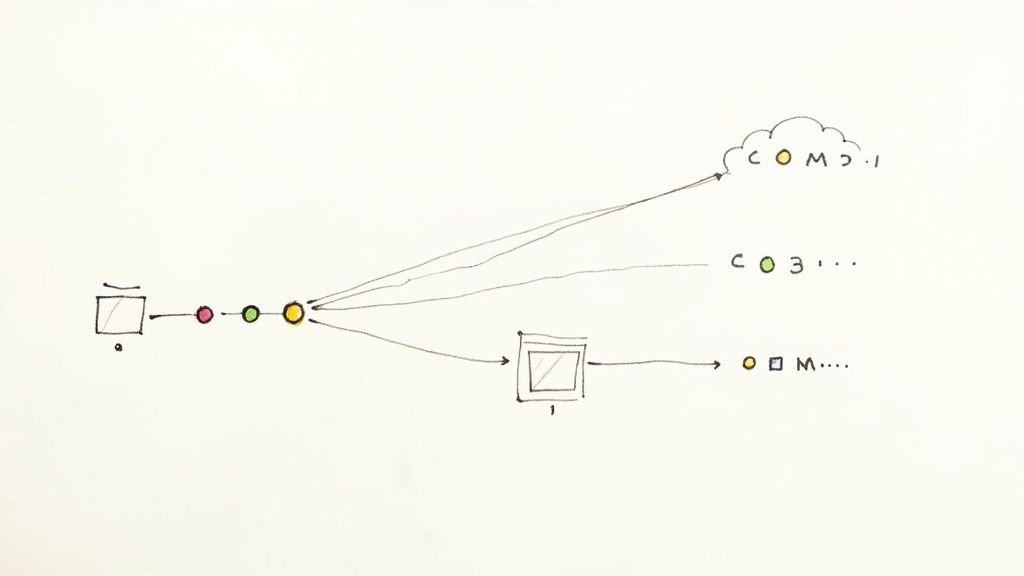Is Jenkins CICD? Complete Automation Guide for Modern DevOps
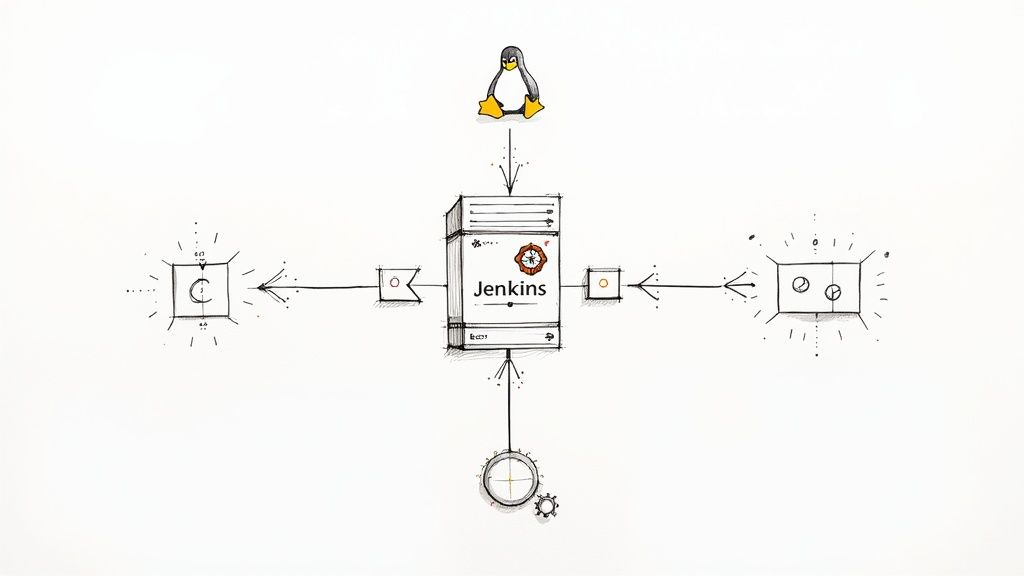
Absolutely. When people ask if Jenkins is a CI/CD tool, the answer is a resounding yes. In fact, it's one of the original and most powerful automation servers out there.
Think of Jenkins as the central command center for a software factory. It doesn't write the code, but it automates and orchestrates every single step that turns that raw code into a working, deployed application.
What Is Jenkins and Its Role in CI/CD
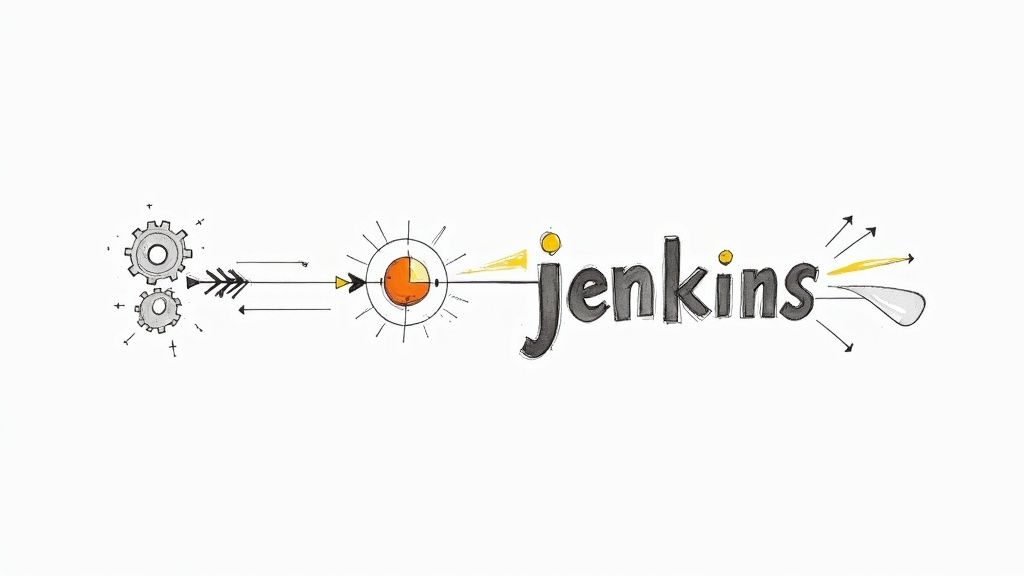
At its heart, Jenkins is an open-source automation engine. It was originally built to master Continuous Integration (CI)—the crucial practice where developers frequently merge their code changes into a central repository, triggering automated builds and tests. This alone was a game-changer.
But Jenkins didn't stop there. Its true superpower is its incredible flexibility, thanks to a massive ecosystem of over 1,800 community-built plugins. This adaptability is what allowed Jenkins to evolve from a simple CI tool into a comprehensive hub for both Continuous Delivery and Deployment (CD).
Bridging Development and Operations
Jenkins serves as that critical bridge connecting development and operations teams, automating the entire journey from a developer's machine to the end user. It’s the engine that powers the modern DevOps mindset.
To see how Jenkins fits into a typical CI/CD workflow, let’s break down its function at each stage.
How Jenkins Powers Each Stage of CI/CD
| CI/CD Stage | Jenkins' Role and Key Actions |
|---|---|
| Commit | Monitors version control systems like Git for new code commits. |
| Build | Automatically pulls the latest code, compiles it, and builds artifacts (like a .jar or Docker image). |
| Test | Executes a suite of automated tests (unit, integration, etc.) to catch bugs early. |
| Deliver | If tests pass, it packages the application and prepares it for release to staging or production. |
| Deploy | Can automatically deploy the application to live servers, completing the hands-free release cycle. |
This automated build-test-deploy cycle is everything. By taking over these repetitive, error-prone tasks, Jenkins frees up developers to do what they do best: focus on writing great code, not getting bogged down in the complexities of manual releases.
For a deeper dive into its core function, our guide on what a CI server is offers a great primer on these essential tools.
Its long history in the industry has cemented its position as a market leader. A 2023 report from the Continuous Delivery Foundation found that Jenkins holds an estimated 44% of the CI/CD market share. That means nearly half of all organizations practicing CI/CD are relying on Jenkins to get the job done.
How the Jenkins Pipeline Works
At the heart of modern Jenkins is the Pipeline, a killer feature that lets you define your entire CI/CD process as code. This "Pipeline as Code" approach is what elevates Jenkins from a simple build tool to a full-fledged CI/CD platform, leaving clunky, UI-based job configurations in the dust.
Forget about manually setting up jobs or dealing with inconsistent environments.
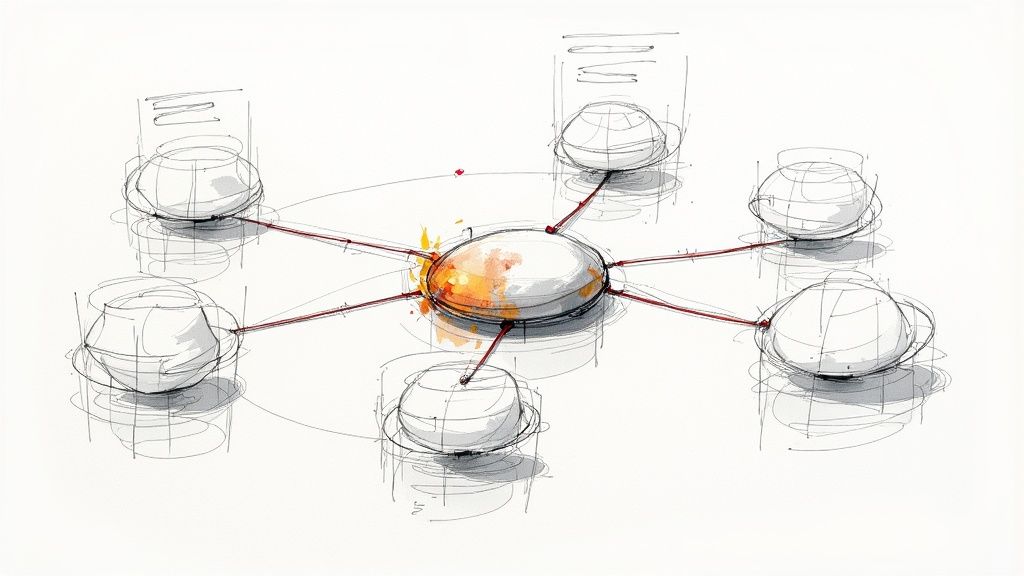
Your entire workflow—from compiling code and running tests all the way to deployment—is laid out in a simple text file called a Jenkinsfile. Think of it as a detailed recipe for your software. The Jenkinsfile lists every single step in the exact order needed to produce a finished, working application.
This method makes your automation process transparent, version-controlled, and dead simple to repeat. Because the Jenkinsfile lives right alongside your source code in your repository, any developer on the team can see and understand the entire delivery process. For a deeper dive, you can learn more about using Jenkins to optimize your CI/CD pipeline and pick up some best practices.
Declarative vs. Scripted Pipelines
Jenkins gives you two different syntaxes for writing a Jenkinsfile, and each has its own vibe. Getting a handle on both is key to figuring out how Jenkins CI/CD will work best for your team.
- Declarative Pipeline: This is the newer, more structured way to do things. It offers a straightforward, almost opinionated syntax that makes it incredibly easy for beginners to get started. Its clear structure helps enforce best practices right out of the gate.
- Scripted Pipeline: This syntax is built on the Groovy programming language. It's the "power user" option, offering massive flexibility for complex logic, loops, and conditional steps. It’s perfect for those unique, gnarly workflows that don't quite fit the standard Declarative model.
A key benefit of "Pipeline as Code" is durability. If your Jenkins server ever goes down, the pipeline definitions are safely stored in your source code repository, not lost within the Jenkins configuration.
Most teams start with Declarative Pipelines because they're so easy to read and maintain. They only switch over to Scripted when they hit a wall and need that extra bit of customization. This dual-syntax approach is a huge reason why Jenkins can handle everything from simple projects to highly complex automation workflows.
To really get a handle on how Jenkins works in a CI/CD setup, you need to understand its moving parts. I like to think of a Jenkins workflow as a well-oiled factory floor. Every piece has a specific job, all working together to make sure the final product—your deployed software—is built correctly and on time.
Understanding the Core Components of a Jenkins Workflow
At the heart of the operation is the Controller, which you might have heard called the Jenkins Master in the past. This is the brain. It's in charge of scheduling tasks, keeping an eye on their progress, and managing all the other components in the system. The Controller itself doesn't do the heavy lifting; it delegates.
That heavy work gets handed off to Agents, previously known as Slaves. These are the real workhorses. An agent can be any machine connected to the Controller—physical, virtual, or even a container—that executes the actual build and test commands. The real power here is using multiple agents, which lets you run jobs in parallel across different operating systems. It’s a huge time-saver for any serious CI/CD process.
The Building Blocks of Automation
With that Controller-Agent architecture in place, the real magic happens in how you define your automation. A few key concepts bring a pipeline to life, turning your source code into a deployable application.
- Job: This is the most basic task Jenkins can run, like compiling a piece of code or firing off a test suite. A Pipeline is just a special, much more powerful, type of job that can orchestrate an entire workflow from start to finish.
- Stage: Think of a Stage as a major milestone in your pipeline. It’s a logical block that represents a distinct phase like 'Build', 'Test', or 'Deploy'. This structure helps you visualize the workflow and neatly separate different parts of the process.
- Step: A Step is a single action inside a Stage. It’s the smallest unit of work you can define, like running a shell command (
sh 'mvn clean install') or grabbing the latest code from Git.
The infographic below shows some of the key metrics you’d track in a Jenkins workflow, like how often you’re building, your success rate, and how long deployments take.
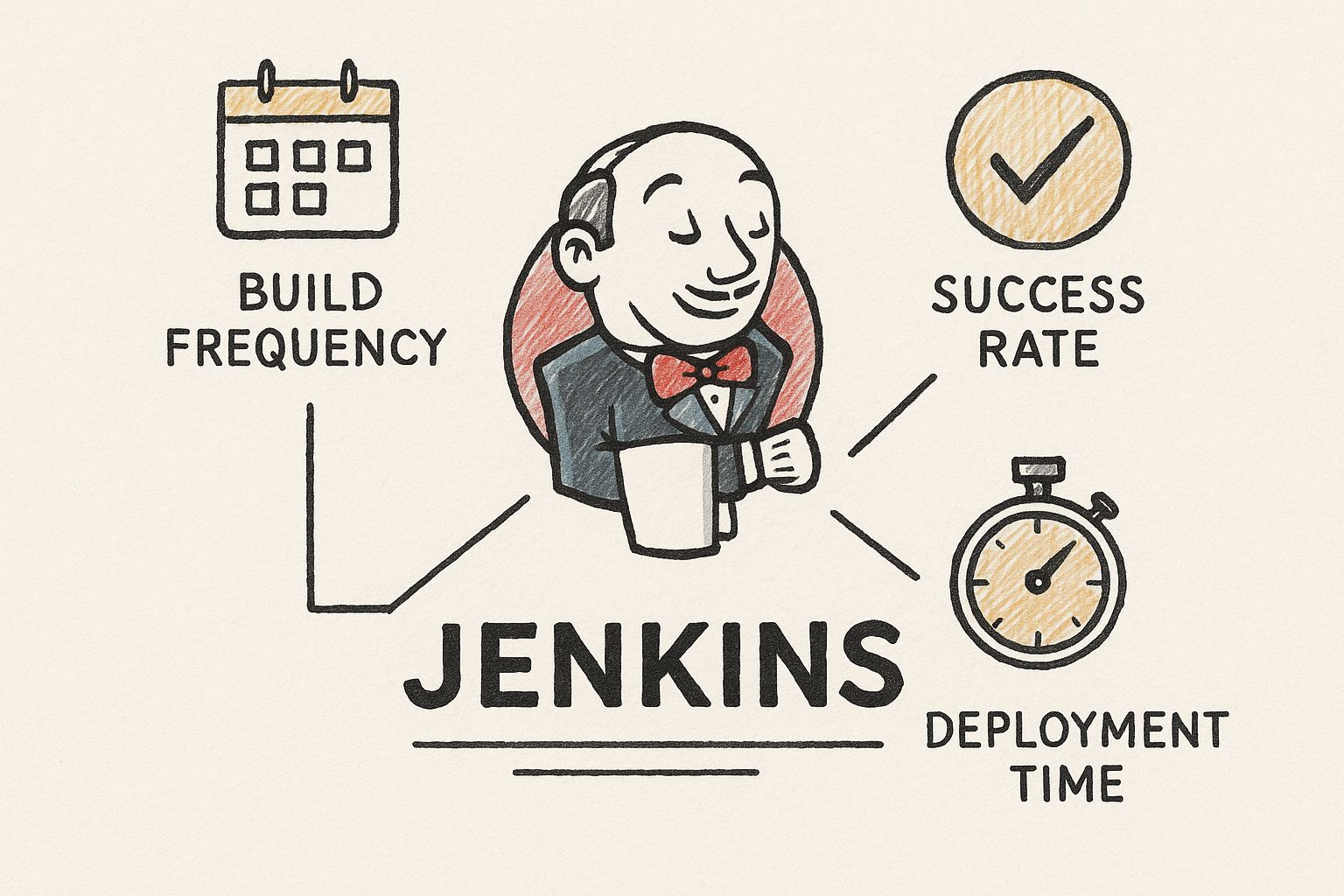
This kind of feedback is crucial for understanding the health and speed of your whole automation process. And it’s clear this model is catching on. The number of Jenkins Pipeline jobs exploded by 79% between June 2021 and June 2023, jumping from 27.1 million to 48.6 million jobs per month.
That’s a massive shift, showing just how many teams are now defining their entire CI/CD workflows as code. You can dig into the numbers yourself in the official Jenkins project growth announcement.
Why Do Top Companies Still Bet on Jenkins?
With so many new, cloud-native CI/CD tools on the market, you have to wonder: why are so many industry leaders still sticking with Jenkins? It’s not about being stuck in the past. It’s about having ultimate flexibility and iron-clad control.
For huge, complex organizations, Jenkins is more than just another tool. It’s the central hub for their entire automation strategy.

The real magic is in its colossal ecosystem of over 1,800 plugins. Think of Jenkins as a completely empty workshop. Other tools might give you a nice, pre-packaged set of machines, but Jenkins gives you the bare floor and a catalog of every specialized tool you could ever dream of. Need to talk to an ancient mainframe, a niche cloud provider, and the newest container registry all in the same workflow? Yep, there’s a plugin for that.
This incredible adaptability makes Jenkins the ultimate automation Swiss Army knife, able to plug into pretty much any tech stack on earth.
The Pillars of Enterprise Trust
For large companies, this kind of open-source freedom isn't just a "nice-to-have"—it's a core part of their long-term strategy. The power to fine-tune every single detail of the CI/CD pipeline gives them a serious competitive edge.
Here’s why it continues to dominate in the enterprise world:
- No Vendor Lock-In: Jenkins is open-source. That means companies are never trapped by a single vendor's product roadmap, pricing whims, or business decisions.
- Proven at Scale: It has a long and storied history of powering some of the biggest and most complicated development environments in the world. It’s battle-tested.
- Massive Community Backing: A huge global community of developers is constantly building new plugins, offering support, and pushing the platform forward.
At its heart, Jenkins is the universal "glue" that can hold a company's unique and often quirky tech ecosystem together. For any organization with highly specific or non-standard workflows, this isn't just a feature; it's an absolute necessity.
This staying power is no surprise when you look at the market. The global DevOps tools market is on track to hit $25 billion by 2025, and a staggering 80% of Global 2000 companies now have dedicated DevOps teams. This boom shows just how critical powerful, adaptable automation engines are. If you want to dig deeper, you can discover more insights on DevOps market growth and see why for many, Jenkins is still the most trusted and versatile choice.
Jenkins Drawbacks and Modern Alternatives
Jenkins is an absolute powerhouse, but that immense flexibility comes with a few strings attached. Like any tool, it has trade-offs, and it's crucial to understand them before deciding if it’s the right fit for your team.
The biggest hurdle is often the administrative overhead. Because Jenkins is self-hosted, your team is on the hook for everything—server maintenance, security patches, performance tuning, you name it. This can quickly become a major time sink, pulling your engineers away from writing code and building features.
Then there's the infamous "plugin hell." The massive plugin ecosystem is one of Jenkins' greatest strengths, but it can also be a source of constant frustration. Managing dependencies between hundreds of plugins, navigating deprecations, and fixing compatibility issues after an update can easily feel like a full-time job.
The Rise of Integrated CI/CD
These operational complexities have opened the door for a new wave of modern, cloud-native alternatives that favor simplicity and tight integration. Tools like GitHub Actions, GitLab CI/CD, and CircleCI operate on a different philosophy entirely. Instead of a separate, standalone tool you have to manage, they build CI/CD capabilities directly into the platforms where your code already lives.
This integrated approach flips the script in a few key ways:
- Managed Infrastructure: The cloud provider handles the servers, security, and scaling. No more late nights patching a server.
- Simplified Setup: Getting started is often as simple as adding a YAML configuration file to your repository.
- Tighter Integration: Workflows are inherently tied to source control events like pull requests and commits, making them feel like a natural extension of your development process.
The core trade-off is control versus convenience. Jenkins gives you the keys to the kingdom, letting you build any workflow imaginable. Modern alternatives offer a more streamlined, managed experience that helps many teams move faster.
This shift in preference is showing up in the data. A recent JetBrains survey noted that while Jenkins is still a top choice in many organizations, GitHub Actions has become the go-to for personal projects, used by 62% of respondents. You can check out the full state of CI/CD survey results to see more trends.
Comparing Jenkins with Cloud-Native CI/CD Tools
To put it all into perspective, let's break down how Jenkins stacks up against the more modern, integrated players like GitHub Actions and GitLab CI.
| Aspect | Jenkins | GitHub Actions / GitLab CI |
|---|---|---|
| Hosting & Maintenance | Self-hosted; requires dedicated team resources for setup, security, and updates. | Cloud-native; infrastructure is fully managed by the provider. |
| Setup & Configuration | UI-based configuration with Groovy-based Pipeline-as-Code (Jenkinsfile). | Purely code-based (YAML files) stored directly in the repository. |
| Customization | Extremely high via a vast ecosystem of over 1,800 plugins. | Highly customizable through a marketplace of actions/components and direct scripting. |
| Integration | Integrates with nearly everything, but often requires configuration via plugins. | Deep, out-of-the-box integration with the source control platform (pull requests, issues, etc.). |
| Best For | Teams with complex, bespoke workflows or strict on-premise security requirements. | Teams looking for a fast, simple, and tightly integrated CI/CD experience. |
Ultimately, the right tool comes down to your team's specific needs. If you're juggling a complex tech stack and need deep, granular control, Jenkins remains a formidable choice. But for teams who prioritize speed and simplicity, a modern alternative might be the smarter path.
To dive deeper, our CI/CD tools comparison guide provides a detailed look at the leading options available today.
Jenkins FAQ: Answering the Tough Questions
To wrap things up, let's dive into some of the questions that always come up when teams talk about Jenkins. These are the practical, real-world concerns that pop up when you're deciding if it's the right automation server for your projects.
Is Jenkins Still Relevant in a World Full of Cloud-Native Tools?
Absolutely. It's a fair question, especially with slick, cloud-based tools like GitHub Actions offering such a streamlined experience. But Jenkins’ superpower has always been its incredible flexibility.
Its massive plugin library is the key. It lets Jenkins talk to pretty much any technology out there, whether it’s brand new or a legacy system that’s been running for a decade. This makes it a lifesaver for big companies with mixed tech stacks that just don't fit neatly into one vendor's box. For them, Jenkins is the central "glue" that holds everything together, orchestrating complex workflows that all-in-one solutions simply can't handle.
At its core, Jenkins is a generic automation engine. While it's famous for CI/CD, its plugin architecture means it can automate almost anything—from running scheduled reports to provisioning infrastructure with tools like Terraform.
What's the Real Difference Between Jenkins and GitLab CI/CD?
It really comes down to philosophy. Jenkins is a standalone, tool-agnostic workhorse. It’s built to integrate with everything and anything, putting maximum control and customization right in your hands.
GitLab CI/CD, on the other hand, is woven directly into the GitLab platform. It provides a seamless, all-in-one experience, which is fantastic for teams that are already all-in on GitLab for source control. The choice boils down to a classic trade-off: Jenkins gives you ultimate flexibility, while GitLab offers a tightly integrated, convenient workflow. If your entire world is inside GitLab, its CI/CD is a no-brainer. If your world is a mix of different tools, Jenkins is often the better orchestrator.
Is Jenkins Hard for Beginners to Learn?
Honestly, Jenkins has a steeper learning curve than most modern SaaS alternatives. There's no getting around it. The initial setup, managing the server, and figuring out all the plugins takes more work upfront. You're responsible for the whole environment, which can feel a bit overwhelming for smaller teams without dedicated ops people.
That said, the introduction of "Pipeline as Code" with the Jenkinsfile has made a huge difference. It completely changed the game by allowing developers to define their CI/CD workflows in a simple text file, which is a much more familiar, code-first approach than clicking through endless UI menus. It still takes more effort to learn than a managed service, but it’s a world away from the complexity of old-school Jenkins.
Tired of managing complex CI pipelines and just want to ship code faster without the drama? Mergify offers a smart merge queue that cuts CI costs, secures your codebase, and ends developer frustration. We automate pull request updates and intelligently batch CI runs to keep your main branch green while saving you a ton of time and money.





